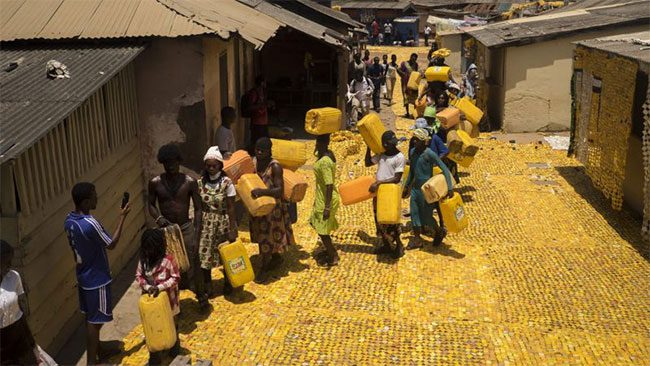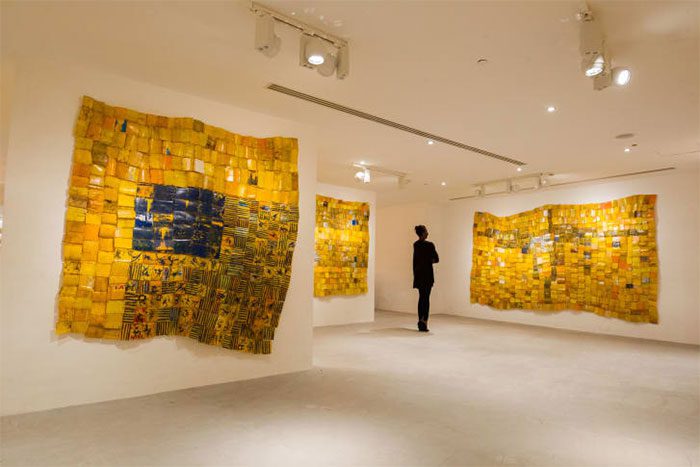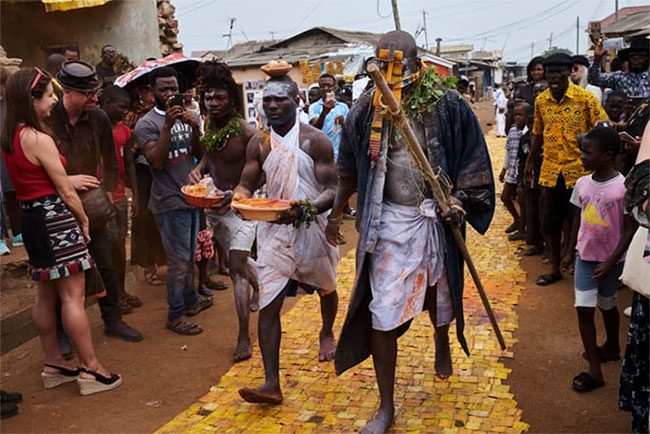The vibrant yellow brick road is not just a fictional concept but has now come to life in the capital of Ghana.
Much like Dorothy in the story The Wizard of Oz, who had to follow the magical yellow brick road to find her way back to Kansas, Serge Attukwei Clottey has created a real yellow road in his homeland of Ghana.

The real yellow road created from cultural materials of Ghana. (Photo: CNN style)
“As an artist, I am interested in the issue of migration. Not just of people, but of objects,” Clottey said in an interview with CNN. The materials used to create Clottey’s yellow road carry special significance in Ghanaian culture. The “Yellow Brick Road” consists of yellow “gallons” or plastic containers that have been repurposed, originally used for transporting imported cooking oil.
Previously, these containers were widely used to carry water in a country that has faced ongoing water shortages, particularly during the presidency of John Kufuor, who served from 2001 to 2009. They became known as “Kufuor gallons”, or simply “gallons.”
“They remain a common sight in Ghana, where one in ten people must walk up to 30 minutes to fetch water,” according to UNICEF. The “gallon” containers symbolize the struggles of daily life, and today they have also become a symbol of African art, since Clottey brought the yellow road to life.
A Transformation
Clottey grew up using containers to fetch water for his family before moving to live with an uncle in a better environment. However, the practical gallons, which have a capacity of 20 to 25 liters, took on a different meaning for the artist born in Accra (the capital of Ghana).
“I saw them as available materials that I could work with for a long time. So, I started piecing them together like a wall and then painted on them,” Clottey explained in CNN’s African Voices.

Bright yellow walls made from Gallons.
Before long, the containers began to pile up, and he had nowhere to store them. He then came up with the idea to cut them up, which was initially met with resistance from the local community. “When I started cutting them, the entire community opposed it because they thought they needed them to survive, and I was getting rid of them, destroying them. It was a complete conflict; I had to convince them that storing water in them was unsanitary,” Clottey shared.
He demonstrated this concept by showing the effects of leaving the containers out in the sun filled with water for several days. The plastic particles could leak into the water, and the high temperatures created a breeding ground for bacteria, making the water potentially unsafe. “So, they began to get rid of them. It was a gradual process where they removed the old ones, bringing them to my workplace; some were donated, while I paid for others,” Clottey said.
The Real Yellow Road
Clottey then began to cut and combine the pieces into his artwork, creating distinctive yellow carpets and using the tops of the containers as masks in photographs, with the round openings symbolizing human mouths. In 2016, after cutting up hundreds of containers, he initiated the “Yellow Brick Road” – his largest public installation, located in the Labadi Beach area of Accra, where he grew up.

The ‘Yellow Brick Road’ preserves the culture of the people of Accra – Ghana.
The pieces were sewn together and, with the help of local residents, were used to carpet the streets of Labadi. The project symbolizes the resourcefulness and resilience of the community. However, its creative boundaries also raised issues of ownership. Many local residents, including Clottey’s family, could not provide proof of ownership of their homes or land due to a lack of documentation. “My family migrated from Jamestown to Labadi. They sold liquor and beef along the coasts, and based on the trade relations my family had with the workers, they secured a place to settle,” Clottey said on African Voices. Ownership issues and disputes in Ghana have persisted for 200 years and continue to this day.


















































